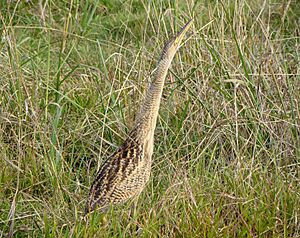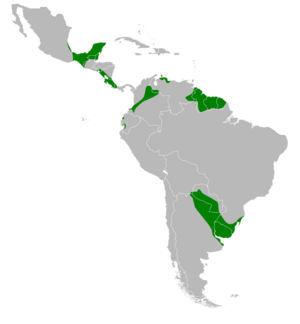Pinnated bittern facts for kids
Quick facts for kids Pinnated bittern |
|
|---|---|
 |
|
| Conservation status | |
| Scientific classification | |
| Genus: |
Botaurus
|
| Species: |
pinnatus
|
 |
|
| Synonyms | |
|
Ardea pinnata Wagler, 1829 |
|
The pinnated bittern (Botaurus pinnatus), also called the South American bittern, is a large bird from the heron family (Ardeidae). You can find it in the warm, tropical parts of the New World, which includes North, Central, and South America. Like other Botaurus bitterns, this bird has feathers that are mostly buffy-brown with patterns that help it blend in. Even though it lives in many places, it's rarely seen. This is probably because it likes to hide, so we don't know much about its life.
Contents
About the Pinnated Bittern
The pinnated bittern is a big heron. It measures about 63 to 76 centimeters (25 to 30 inches) long. It weighs between 554 and 1157 grams (1.2 to 2.5 pounds). Male bitterns are usually heavier than females. Both male and female birds look similar, but females are often smaller. Also, females have brown feathers on their tail, while males have black ones.
Both young and adult bitterns are generally buffy-colored. They have many patterns that help them hide in their surroundings. Young birds tend to have a slightly more reddish color. Their throat is plain white, and the front of their neck is white with light brown streaks. The rest of their neck is buff with thin black stripes. Their chest and belly are white with wide, light brown streaks. The back is buff with lots of black streaks and bars. The tail feathers are black in males and brown in females. When they fly, their slate-grey wing feathers make them look like they have two different colors.
The bittern's beak is thick and strong. It's yellowish overall, with a darker upper part. The skin around its face is bright yellow, and a brown line runs across the area between its eyes and beak. Its legs are greenish-yellow, and its eyes are yellow.
What Does It Sound Like?
If a pinnated bittern is startled and flies away, it makes a rough rawk-rawk-rawk call. During the time of year when they have babies, the male bird makes a deep poonk or poonkoo sound. He usually does this at dusk and through the night.
Pinnated Bittern Family Tree
A German naturalist named Johann Georg Wagler first described the pinnated bittern in 1829. He first put it in the genus Ardea. Some scientists think it's part of a "superspecies" with the American bittern (B. lentiginosus). A superspecies is a group of very closely related species that are so similar they might be considered one species. Other experts think that all birds in the Botaurus genus are part of one big superspecies.
There are two main types, or subspecies, of the pinnated bittern. They are separated by a gap in Central America:
- Botaurus pinnatus caribaeus Dickerman, 1961 – This type lives in eastern Mexico, Belize, and sometimes in Guatemala.
- They usually have a longer beak, shorter wings and tail. They are also paler and have fewer streaks on their throat.
- Botaurus pinnatus pinnatus (Wagler, 1829) – This type lives from southeastern Nicaragua down to Ecuador and the Guianas. It also lives south through Brazil to Paraguay and northeastern Argentina.
- They usually have a shorter beak, longer wings and tail. They are darker and have more streaks on their throat.
Where They Live and How They Live
The name "South American bittern" can be a bit confusing because this bird also lives as far north as southern Mexico. Its home range stretches from the Atlantic side of southeastern Mexico all the way to northern Argentina. However, there are not many sightings in Guatemala and Honduras. These birds mostly live in low-lying areas. But they have been seen in the Cordillera Oriental mountains of Colombia as high as 2,600 meters (8,500 feet) above sea level.
Pinnated bitterns can be found in many different freshwater places. These include thick reed beds, edges of lakes, and flooded grasslands with tall plants. They also live in marshes and overgrown ditches. The plants in their homes are usually tall sedges, water hyacinth, rushes, reeds, or cattails. They also use fields where rice or sugarcane are grown.
The pinnated bittern is mostly active at night. While they usually live alone, they might gather in small groups where there's a lot of food. When they get scared, they tend to freeze. They crouch low to the ground and raise their head just enough to see. They usually only fly away if you get very close to them.
We don't know how many pinnated bitterns there are or if their numbers are changing. But because they live in such a wide area, the IUCN considers them a species of Least Concern. This means they are not currently in danger of disappearing.
What They Eat
The pinnated bittern eats many different things. Their diet includes fish (even eels), reptiles, amphibians, baby birds, arthropods (like insects), molluscs (like snails), worms (like leeches), and small mammals. They have even been known to eat young common marmosets. They usually catch their food by waiting quietly. The pinnated bittern is a patient hunter. It often stands still for a long time, waiting for its prey to move close enough to catch.
Reproduction and Life Cycle
Unlike most herons, the pinnated bittern usually nests alone. Its nest is a flat platform or a shallow cup made of plant material, like rush stems. They usually build it among thick plants, not far above the water. The female lays two to three olive-brown eggs. It is believed that only the female bird sits on the eggs to keep them warm until they hatch. Pinnated bitterns almost always have their babies during the wet season.
Images for kids



